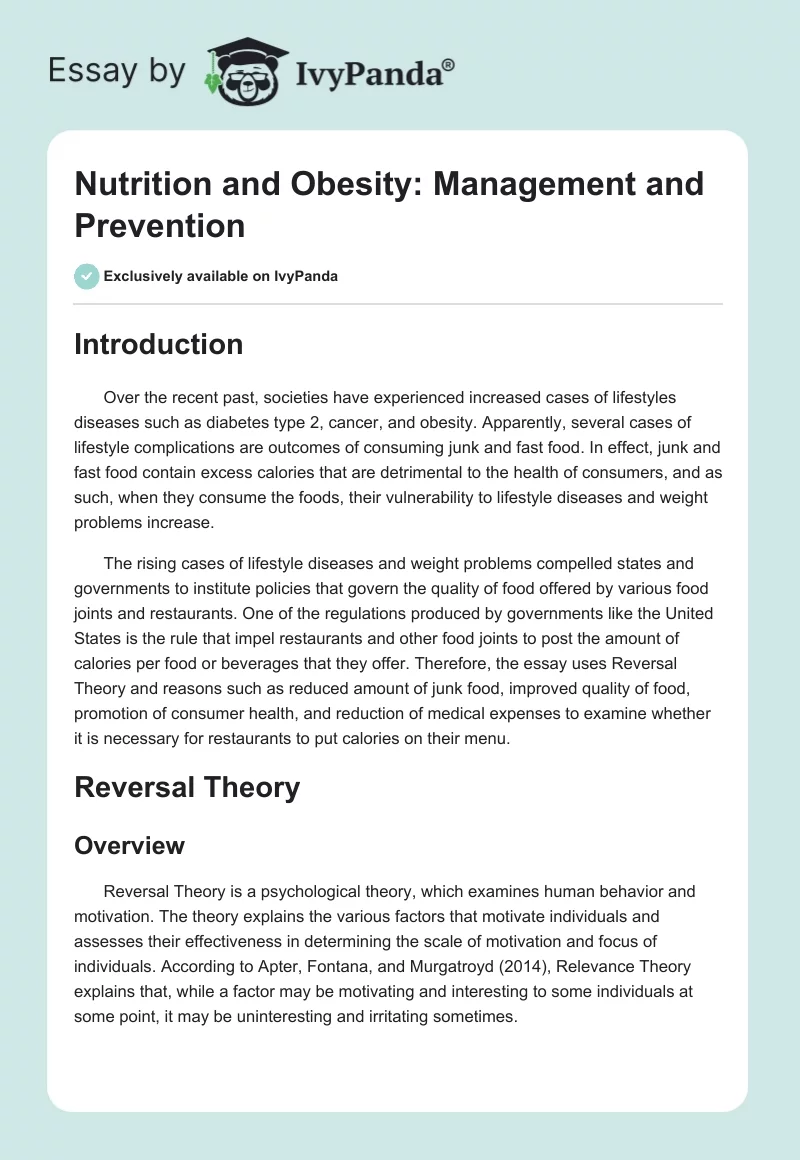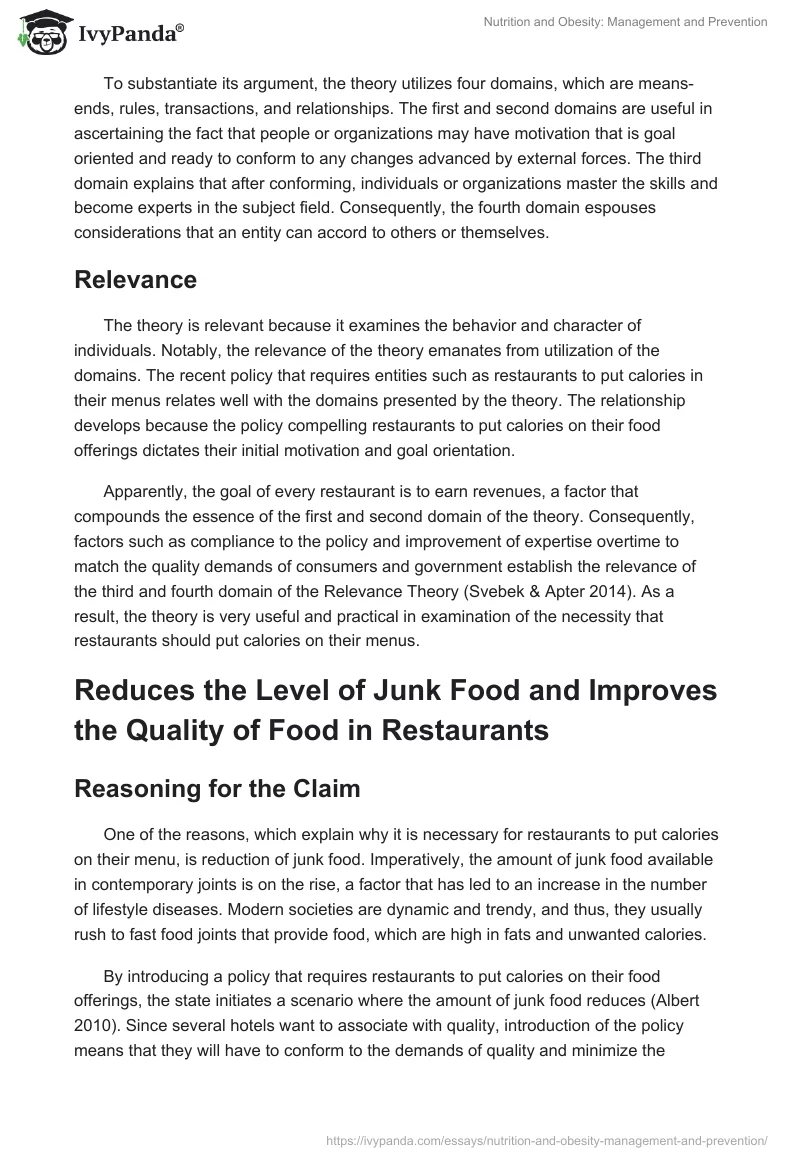Introduction
Over the recent past, societies have experienced increased cases of lifestyles diseases such as diabetes type 2, cancer, and obesity. Apparently, several cases of lifestyle complications are outcomes of consuming junk and fast food. In effect, junk and fast food contain excess calories that are detrimental to the health of consumers, and as such, when they consume the foods, their vulnerability to lifestyle diseases and weight problems increase.
The rising cases of lifestyle diseases and weight problems compelled states and governments to institute policies that govern the quality of food offered by various food joints and restaurants. One of the regulations produced by governments like the United States is the rule that impel restaurants and other food joints to post the amount of calories per food or beverages that they offer. Therefore, the essay uses Reversal Theory and reasons such as reduced amount of junk food, improved quality of food, promotion of consumer health, and reduction of medical expenses to examine whether it is necessary for restaurants to put calories on their menu.
Reversal Theory
Overview
Reversal Theory is a psychological theory, which examines human behavior and motivation. The theory explains the various factors that motivate individuals and assesses their effectiveness in determining the scale of motivation and focus of individuals. According to Apter, Fontana, and Murgatroyd (2014), Relevance Theory explains that, while a factor may be motivating and interesting to some individuals at some point, it may be uninteresting and irritating sometimes.
To substantiate its argument, the theory utilizes four domains, which are means-ends, rules, transactions, and relationships. The first and second domains are useful in ascertaining the fact that people or organizations may have motivation that is goal oriented and ready to conform to any changes advanced by external forces. The third domain explains that after conforming, individuals or organizations master the skills and become experts in the subject field. Consequently, the fourth domain espouses considerations that an entity can accord to others or themselves.
Relevance
The theory is relevant because it examines the behavior and character of individuals. Notably, the relevance of the theory emanates from utilization of the domains. The recent policy that requires entities such as restaurants to put calories in their menus relates well with the domains presented by the theory. The relationship develops because the policy compelling restaurants to put calories on their food offerings dictates their initial motivation and goal orientation.
Apparently, the goal of every restaurant is to earn revenues, a factor that compounds the essence of the first and second domain of the theory. Consequently, factors such as compliance to the policy and improvement of expertise overtime to match the quality demands of consumers and government establish the relevance of the third and fourth domain of the Relevance Theory (Svebek & Apter 2014). As a result, the theory is very useful and practical in examination of the necessity that restaurants should put calories on their menus.
Reduces the Level of Junk Food and Improves the Quality of Food in Restaurants
Reasoning for the Claim
One of the reasons, which explain why it is necessary for restaurants to put calories on their menu, is reduction of junk food. Imperatively, the amount of junk food available in contemporary joints is on the rise, a factor that has led to an increase in the number of lifestyle diseases. Modern societies are dynamic and trendy, and thus, they usually rush to fast food joints that provide food, which are high in fats and unwanted calories.
By introducing a policy that requires restaurants to put calories on their food offerings, the state initiates a scenario where the amount of junk food reduces (Albert 2010). Since several hotels want to associate with quality, introduction of the policy means that they will have to conform to the demands of quality and minimize the amount of excess calories in their food. By conforming to the demands of quality and minimizing the amount of calories in their food, the level of junk food reduces.
Besides reducing the amount of junk food offered by restaurants, the policy also improves the quality of food. In the quest to abide by the requirements advanced by the policy, restaurants minimize the amount of calories in their food and strive to deliver foods that meet the required standards. It is paramount to explain that while some restaurants provide food that match quality requirements, others focus on revenues instead of quality.
The focus on revenues has led to production of fast foods that are very low in quality and detrimental to human health. According to Haber (2013), the policy of placing calories on restaurant menus plays a very important role in reducing the amount of unhealthy food and improving quality. Therefore, by introducing the policy, the government has played an instrumental role in regulating the quality of food that restaurants deliver to their clients.
Promotes the Health of Consumers
Reasoning for the Claim
Promotion of consumer health is another very important reason that substantiates the relevance of placing calories on menus. When restaurants place calories on their menus, health oriented consumers can get the chance to monitor the amount of calories that they take in every time they order and consume a given food or beverage. In addition, those individuals, who are under medication can focus and understand the kind of food that contain the required amount of calories as prescribed to them by medical practitioners.
Bagchi (2011) explains that the policy commences a step in the process of curbing lifestyle problems and minimizing weight issues in the United States. As such, the relevance of placing calories on menus is one that researchers cannot underscore. The fact that consumers have more liberty and knowledge about what they take implies that they can easily manage their health by consuming what contains the optimum amount of calories.
Consequently, the policy forces restaurants to improve the quality of food that they offer to their consumers. By improving the quality of food that they offer, restaurants boost the health of clients, who consume their food or beverages. In the assertion of Albert (2010), several hotels that have started complying with the regulation are those that have high quality food. Therefore, in the advent of necessitating the policy in various parts of countries like Britain and the United States, hotels will have to conform to the regulation by improving the quality of food and beverages. The aftermath of improved quality of food and beverages is a simultaneous enhancement of client health.
The policy eventually leads to the closure of those joints, which fail to comply or adopt the healthy requirements of food. Since the amount of calories determine the quality of food, putting them on the menu implies that consumers get the chance to see what the restaurants offer in relation to quality, and thus, make informed choices concerning what is healthy or unhealthy.
Reduces Medical Costs Incurred as a Result of Consuming Fast Foods
Reasoning for the Claim
The relevance of the policy in minimizing medical costs incurred by individuals, who suffer from lifestyle complications after consuming fast foods, emanates from its ability to improve the quality of food. Notably, the increasing cases of lifestyle diseases and weight problems, which characterize modern societies, are outcomes of high calorie food consumed by individuals. Since majority of individuals in trendy societies consume foods from fast food joints and restaurants, most of them take in excess calories.
Kazaks and Stern (2013) elucidate that excess calorie, which supersede the amount required by the body otherwise known as ‘Basal Metabolic Level’ catalyzes vulnerability of an individual to lifestyle complications and weight problems. However, by introducing and making the regulation of placing calories on menus compulsory, governments ensure that individuals experience minimal problems associated with fast foods. By advocating for improved quality of food, the policy ensures that restaurants not only focus on the revenues, but also focus on the health state of their food offerings.
Conclusion
The policy that compels restaurants to put calories on their menus is one that is very useful in management of lifestyle diseases and weight problems. Significantly, the relevance of putting calories on the menus stems from the benefits that occasion after implementation of the policy. Improved quality of food, reduction of junk food, advanced health of consumers, and reduction of medical expenses are some of the notable reasons, which substantiate the essence of putting the amount of calories on the menus.
Besides, helping consumers make informed decisions concerning healthy and unhealthy food, the policy will also expand the scope of several low-end restaurants and food joints that focus on revenues and downplay the health of consumers. Therefore, it is necessary for restaurants to put calories on their menus.
Reference List
Albert, J 2010, Innovations in food labeling, Food and Agriculture Organization of the United Nations, Rome.
Apter, M, Fontana, D & Murgatroyd 2014, Reversal Theory: Applications and Development, Psychology Press, London.
Bagchi, D 2011, Global perspectives on childhood obesity: current status, consequences and prevention, Routledge, London.
Haber, D 2013, Health Promotion and Aging: Practical Applications for Health Professionals, Springer Publishing Company, New York.
Kazaks, A & Stern, J 2013, Nutrition and obesity: assessment, management, and prevention, Jones & Bartlett Learning, Burlington.
Svebek, S & Apter, M 2014, Stress and Health: A Reversal Theory Perspective, Taylor & Francis, London.


